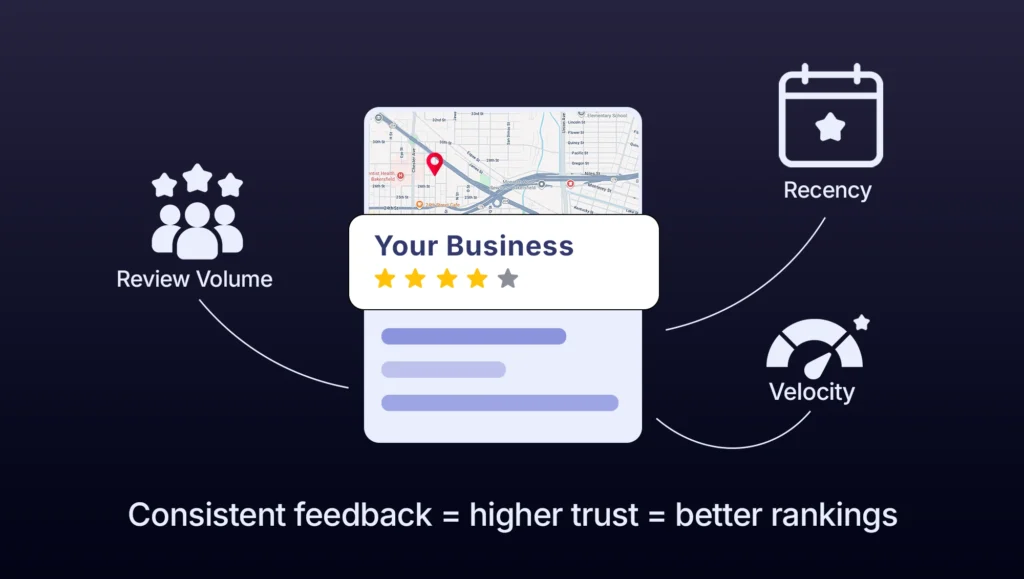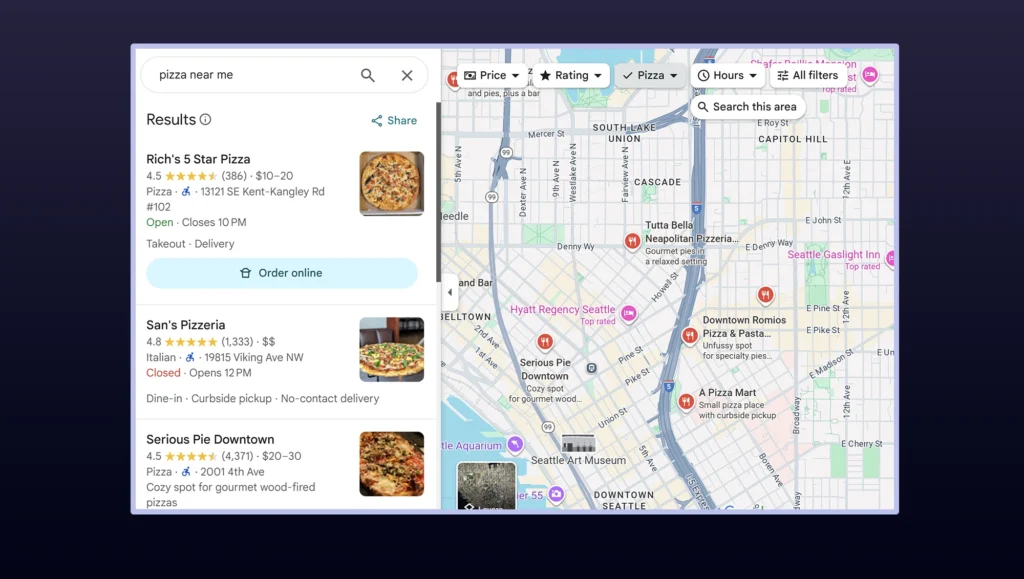When you are contemplating purchasing a product, what’s the first thing you do? You search for it on Google, check out reviews, and decide if it’s worth your time and money. In the digital-first world, online reviews matter more than any ad campaign. They’re a key factor in your search engine rankings, credibility, and conversion success; not just digital word of mouth.
Online review management isn’t a passive activity. It’s an often-overlooked SEO strategy. Fresh and authentic feedback boosts engagement, visibility, and rankings across platforms like Google Reviews, Yelp, Facebook, and Trustpilot; and Google’s algorithm rewards businesses with consistent, relevant reviews.
In this guide, we will break down all aspects of online review management for local business and how you can strategically use them to boost your brand’s online presence and rankings.
How Reviews Affect Search Rankings
Brand mentions, even if they don’t include a link to your business’s website matter. Whenever a customer mentions your business somewhere on the web, they are boosting your credibility with Google. This is why review management goes beyond public perception. It is about accessibility, credibility, trustworthiness, and converting the search engine to become your best sales representative.
Google considers review volume, recency, and velocity as trust signals to indicate activity on your business. It prefers to display search results from active businesses that consumers find relevant. If a business shows consistent and authentic feedback, it’s a win in Google’s books!

For Local SEO, your Google Business Profile (GBP) is very valuable. Your GBP contributes significantly to how you appear in the Map Pack. Google wants to show active and relevant businesses found in GBP. The more reviews you have, and the more recent and consistent those reviews are, the better your chances are of getting ranked in the top three.”
Optimizing Google Business Profile for Reviews
Your GBP isn’t just a digital business card, it’s your starting point for local visibility. If you haven’t already, being set up and verified on GBP is step one. Keeping your NAP information (Name, Address, Phone), business categories, and hours of operation always updated helps Google trust your listing and display it in searches.
Once your GBP is live, responding to reviews should be a recurring workflow. Respond to every review, good or bad! It shows that you are engaged and care about your customers. For positive reviews, reply with a simple, personalized thank you. For negative reviews, try to keep it calm, apologize as needed, try to get to the root of the issue, and then try to get the conversation offline for better assistance. And yes, it doesn’t hurt to sprinkle in relevant keywords (like “family dentist in New Jersey” – Google picks up on these as well) – think of reviews as part of an SEO strategy.
Reviews Across Multiple Platforms
Online reviews aren’t siloed. Even though they’re scattered across the web, and Google sees every one of them. To stay competitive, shape your reputation on every platform your customers use, not just Google. Meet them where they search and build trust everywhere they look.
Not All Reviews Carry the Same Weight
When it comes to local SEO, Google reviews are significant for many reasons. Other platforms such as Yelp, Trustpilot, and Facebook help to validate you and help with overall reach. Search engines love consistency. All reviews won’t be the same, but when reviews from multiple platforms have similar quality and tones, it amplifies your online authority and helps you rank competitively in organic search results.
Social Proof Goes Beyond Google
When it comes to niche markets, review sites such as TripAdvisor, Zillow, or G2 often rank very highly in searches. Don’t forget about Facebook, LinkedIn, and well, Amazon – they play a crucial role in determining how you’re perceived and discovered as a business.

Generating More Positive Reviews
Positive reviews don’t appear out of thin air — they are encouraged with smart timing and subtle initiations. When a customer is satisfied with a service, they are often eager to share it. Your business just needs to find the right way to ask, naturally and easily. With the right approach and the right tool, you can make review generation feel like an effortless, natural step in your customer journey.
Ask the Right Way, at the Right Time
The best reviews are honest, spontaneous, and gently requested. Follow up after a purchase and send a quick email or SMS, usually within 24-48 hours when your customers emember your service and are more likely to engage with you. You can also use a QR code on a receipt or some promotional packaging. And yes, giving an offer like a discount, gift card, or loyalty points is encouraged as long as you do not violate the platform’s policy.
Automate Without Losing Human Touch.
Automation can help your business grow its reach without sacrificing the human touch. Timely review requests triggered after key actions (like the completion of a service or receiving a product) feel natural and responsible. With ongoing review management, these messages can be aligned to your brand tone, and should automate happy customers leaving a review and following your business, effortlessly.
Handling Negative Reviews and Reputation Management
Your business is bound to receive some type of negative review at some point. The important thing is how it’s handled. Ignoring bad reviews may have consequences for your online visibility, brand credibility, and ultimately your conversions. But when it is handled with intention, even a bad review can be an opportunity to show integrity and possibly even benefit your local SEO!
Respond Strategically, Not Emotionally
Before responding to the negative review, take a moment to pause and breathe. Read the review, acknowledge the problem, and attempt to help. If need be, take the discussion to a private conversation. Don’t get defensive, or dismissive; people can tell.
Recover, Remove, and Rebuild
If the review was bogus or it blatantly crosses the line of what the platform will allow, flag it for removal. For more severe reputational hits like bad press or viral complaints, focus on responding thoughtfully, accumulating new positive reviews, and being honest and transparent. A good reputation management software like Cube can help your team stay organized, and auto-respond with personalized responses while monitoring sentiments to better your brand’s customer service.
Leveraging Reviews for SEO and Marketing
Reviews are more than just online attaboys from satisfied customers; They are valuable assets to a business. Used correctly, they can improve your SEO, increase clicks, and provide your marketing with an authentic presence that money can’t buy. Think of them as built-in content for you long after the sale is made.
Turn Reviews into Optimized Content
Search engines like real, unique, and updated content, which is essentially what reviews are. Add schema markup to have them displayed as rich snippets in search engine results via Google. It’s a low-effort way to get some unique placements. You’ll also build instant credibility and time on site by embedding reviews on your landing and/or product pages. This is beneficial for SEO.
Expand Reach through Socials and Ads
A great review will do more than just make your day; it can be the anchor of your next campaign. Use it in a social post, share it in a story, use it as a testimonial ad, etc. Newly found voices will always resonate. When done correctly, you aren’t just storing reviews; you are showing reviews in almost every way to get your results.
Review Schema Markup for SEO
If you want your business to leverage reviews for improved search visibility, adding schema markup makes perfect sense. It allows Google to understand the context of your reviews, which ultimately can get you rich snippets in search results (those star ratings that you see under listings), which equals more visibility, more clicks, and better SEO.
Understanding the Types of Review Schema
There are various types of schema, which depend on what you are displaying. Use ‘Product’ for product items, ‘Service’ for services offered, like consulting or cleaning, and ‘LocalBusiness’ for general reviews about a business. ‘AggregateRating’ combines multiple reviews into one average score, which is great for quantifying general customer sentiment in search.
Implementing and Testing Schema the Right Way
Schema markup can be quickly added to a website using JSON-LD, a lightweight scripting format recommended by Google. JSON-LD can be placed directly in your site header or added directly through your CMS. Once you add it to your website, test it using Google’s Rich Results Test or the Schema Markup Validator. Clean, valid markup gives you the best chance for eye-popping results in search.
AI and Automation in Review Management
AI is changing the way businesses are managing reviews online. While they originally offered a way for companies to respond faster to customers and be alerted to issues sooner, they offer businesses a way to automate their review processes and, ultimately, help manage a strong brand image. AI also removes some of the manual labor and mitigates the risk of some errors slipping through the cracks. Today, AI has become an absolute necessity to manage reviews at scale.
Smarter Monitoring and Responses
AI tools scan reviews across platforms for tone, keywords, and urgency. They highlight critical issues and even give the company suggested responses to save time. This way, replies stay timely, on-brand, and consistent. When AI tools enhance a business’s ability to engage and respond to reviews, it increases the efficiency of taking action based on feedback.
Prevention Through Prediction
Similarly, predictive analytics reveal patterns that lead to negative experiences. Identifying problems ahead of public complaints disarms them. Businesses also now have chatbots to elicit real-time feedback and respond to concerns early, creating an automated barrier in the form of potential reputation detractors.
Tracking and Measuring Review Performance
Collecting reviews is only half the battle, the real learning lies in tracking performance. Metrics like volume, star ratings, and sentiment trends are how you quantify your impact. Consistent tracking and analysis will identify the patterns in customer perception. This will enable businesses to continue refining their approach to review management.
Use the Right Tools and Metrics
Take time to get started with Google Search Console and Google Business Profile insights. Both analyze search impact and visibility of your business. For deeper analysis, consider using a third-party tool or service like Yext, Podium, or Reputation.com. These tools will allow you to track performance across multiple channels to identify trends and sentiment, and reveal engagement from past customers. Prioritize assembling a fully rounded view of your online reputation.
Audit, Analyze, Improve
Conducting regular review audits will allow you to highlight aspects that require slimming down. For example, if you notice response times declining or increasing complaints, regular audits will allow you to proactively spot weak areas. Track and compare performance over time to assess what is working and not working. Identify if there are gaps in star ratings across locations or services. Aspects identified from your audits will help keep your business lively and competitive.
Future Trends in Review Management and SEO
Online reviews are evolving quickly and so are search engines’ interpretations of them. With AI-generated content, voice feedback, and stricter algorithms, the landscape is evolving. Businesses that embrace change early will have a leading edge regarding visibility and trust. The future of review management will be smarter, stricter, and more fluid.
Smarter Tech, Smarter Filters
AI is already being used to detect fake reviews and platforms may start penalizing inauthentic activity even more. Google is favoring quality, recency, and originality with its algorithms. As platforms improve their detection of fake reviews, businesses will increasingly rely on transparency and authenticity for credibility.
New Formats and New Frontiers
Video reviews, voice feedback, and even blockchain-authenticated reviews are lambasting online buyers. These newer formats bring higher engagement and trust than traditional reviews, and require new methods of management and moderation. Remaining flexible and open to more emerging formats will be essential in staying relevant as both search engines and customers change.
Supercharge Your Brand’s Online Reputation With Cube
Reviews shape customer trust and search rankings. So managing them isn’t optional, it’s strategic. Whether you’re on Google, Yelp, or niche platforms, a disciplined review program pays off in higher visibility, stronger credibility, and more conversions.
Cube makes it all simple: track the right metrics, automate timely responses, and keep fresh feedback flowing. Stay proactive, stay authentic, and let us turn every review into a growth lever, so you’re always one step ahead of algorithms and customer expectations.


